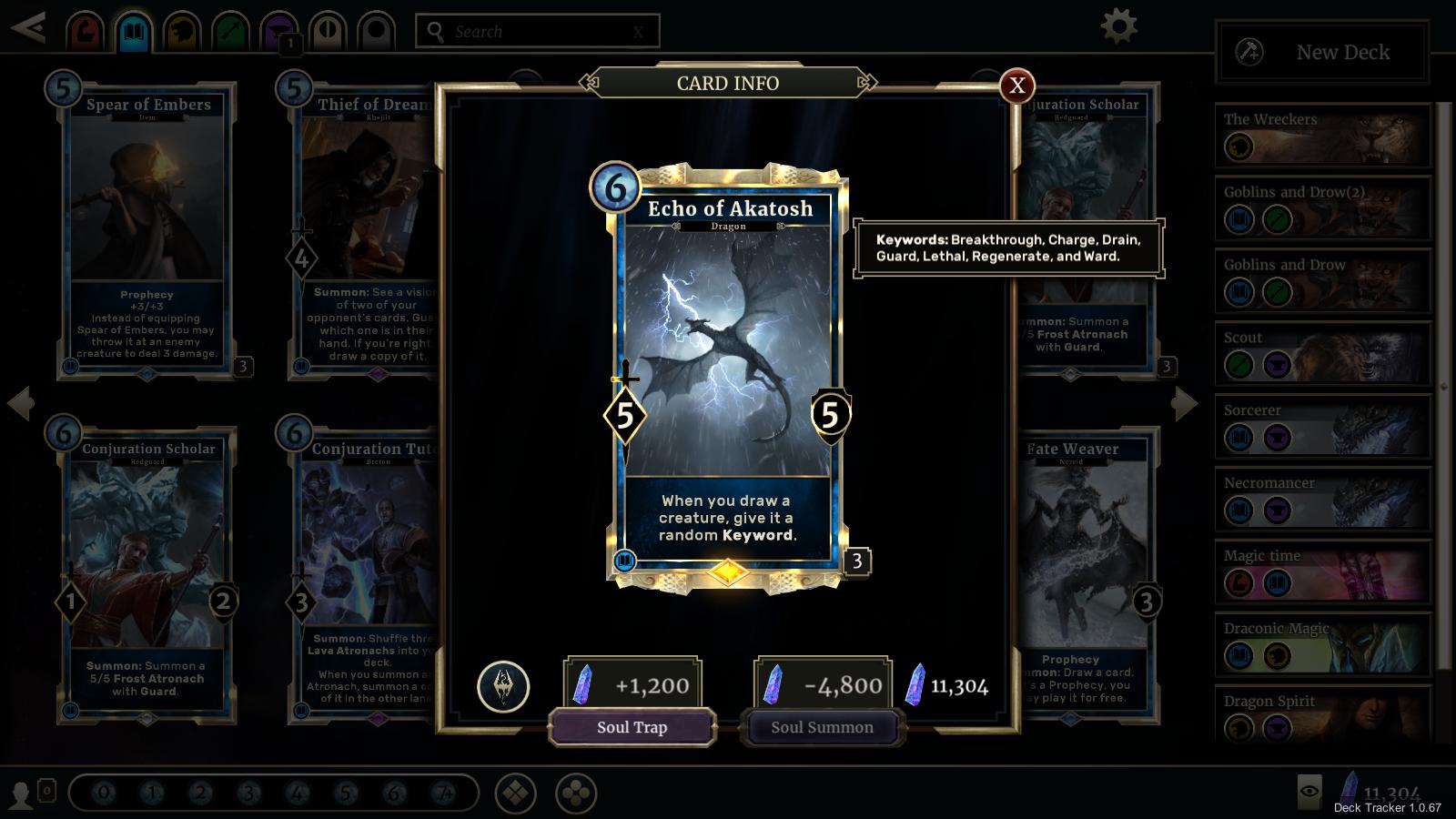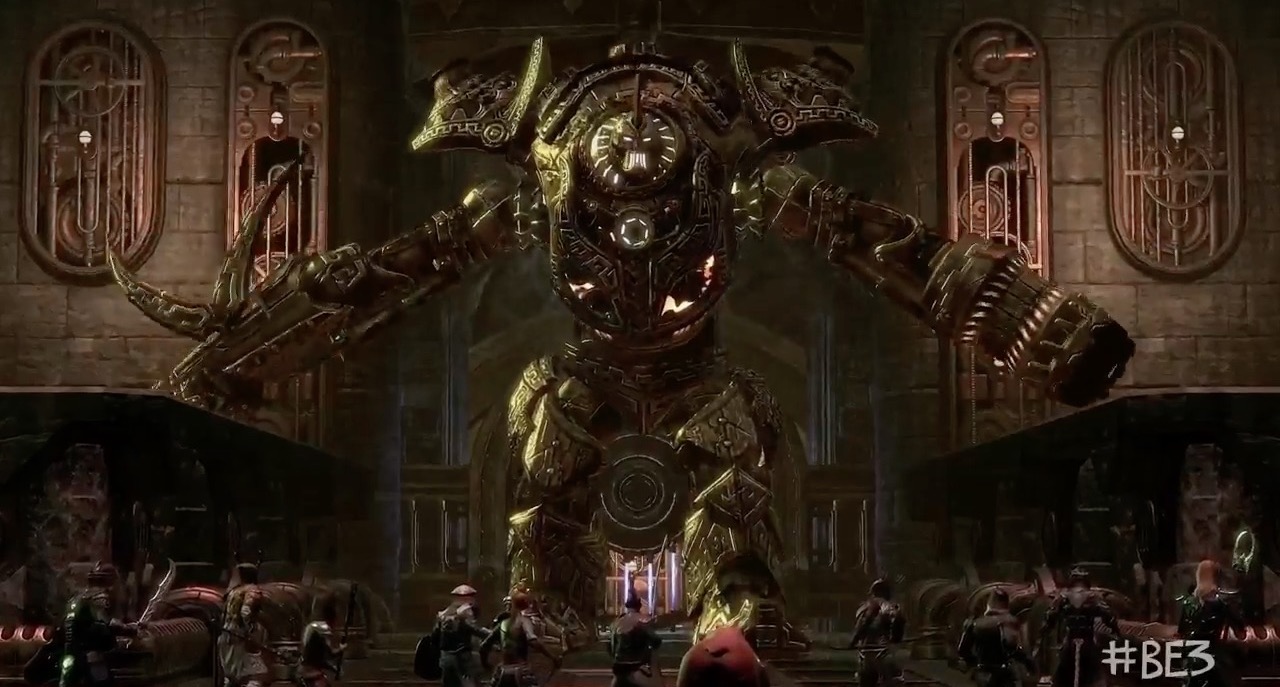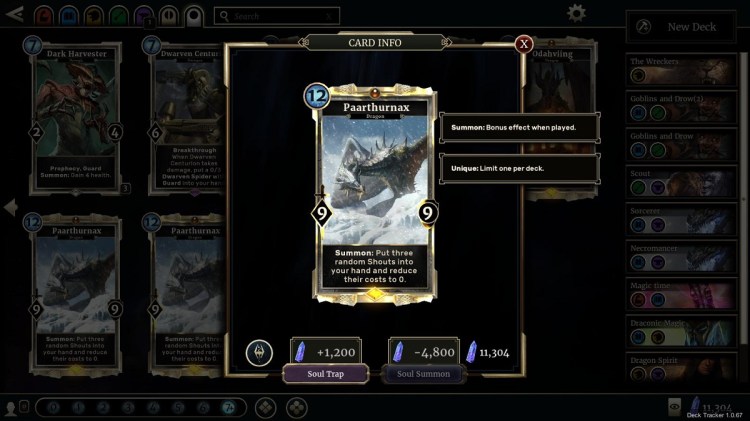
Above: Echo of Akatosh is a dragon that gave random effects to every card in your deck until a recent change.
GamesBeat: The first set of card changes hit the dragon Echo of Akatosh, my favorite card. Why did you just change it to the top card each turn, as opposed to your entire deck, and make it more expensive?
Hines: It’s for two reasons. No. 1, you don’t want to have a card that gets played have this massive ongoing effect even if it dies right away. A card like Alduin, or a card like Parthuurnax, or whatever it is, if you immediately Silence it or Piercing Javelin it and kill it, it hasn’t gone bonkers forever. But Echo of Akatosh, just by playing it, immediately did something to the rest of your deck forever that your opponent couldn’t do anything about.
It’s really more about interactability, which is something we try to lean into and highlight in Legends. The ability to play prophecies off runes that are broken on your opponent’s turn changes the strategy of the game and the way you sequence when you play your cards, and how you attack. Creating this ongoing effect for your deck that your opponent can’t interact with was a negative experience.
GamesBeat: Did that outweigh the fun people were having with that random effect?
June 5th: The AI Audit in NYC
Join us next week in NYC to engage with top executive leaders, delving into strategies for auditing AI models to ensure fairness, optimal performance, and ethical compliance across diverse organizations. Secure your attendance for this exclusive invite-only event.
Hines: Yeah, but that’s the point. There’s other cards in the game that have a similar effect, but they only impact the cards on the battlefield at that time. Making every card in your deck more powerful by playing one card—it’s not a support that your opponent can silence or blow up. It was just, well, he did that, and now I can’t do anything about it. The problem in this case wasn’t that it was too powerful and it was breaking the meta, because it turned out, on the ladder, especially at the higher levels—folks figured out pretty quickly that while you’re doing that, you’re going to be dead before you draw any of those cards, because I’ll do this and this and this and then kill you. That’s how you deal with it. It was more of a player perception—not having a card that people simply didn’t feel good about. That’s important to us. Even if the actual power level wasn’t overpowered, the way people felt about it was such that we needed to adjust it and bring it more in line.
GamesBeat: It’s a case of my fun was ruining the fun of 20 other people.
Hines: Yeah, exactly. If the thing that you’re doing, your opponent can literally do nothing about it, that tends to create a less fun, less interactive game, which is not what we want Legends to be.

Above: The Elder Scrolls Legends’ mobile UI is slick.
GamesBeat: I like how the UI feels on the screen in the mobile version. I’ve even been able to build decks. It doesn’t feel as convoluted as in some other card games in the mobile version. How hard was it, and how long did it take you to come up with the UI for this?
Hines: Very and long. [Laughs] It’s exactly what you said. It’s iterating and reiterating. The UI is such a tough thing to get right. The relative size of the cards on the screen, fitting all of those on a battlefield, how you zoom in on them—it wasn’t as much of a technical thing, how we get this to run on these devices. That just isn’t as big of a deal anymore. It’s more about, if this is the only way I’m experiencing this game, can every single part of this feel okay? How many cards do we put on the deck collection screen when you’re trying to build a deck? All those things. Even just simple things like—you’ve probably noticed, between the phone and the PC, some buttons aren’t in the same place you expect them from the PC layout, because of some design choices we made. We need to move that somewhere else to allow more space, or to try to reduce the chance that you mis-click. You’re trying to look at your graveyard and you accidentally hit pass turn, well, that’s about as bad an experience as you can have. Figuring out the space that we need on a much smaller screen, and potentially moving things where folks aren’t used to it, but once you play it you understand why this is here and that is there now.
GB: I like how well it highlights what quests you have, your dailies, better on mobile than it does on the PC.
Hines: That’s actually a thing we’ve continued to try to iterate on with the PC version – how to better and better point folks toward where their quests are without them having to go check their character screen to see what they are. I just know I must have one for versus arena because I have a quest thing on it. Those things, we were doing them on PC in part with an eye toward the mobile release and trying to make that more accessible and easy to find. Again, you just don’t have the real estate. You don’t want people having to click 10 times to find a simple piece of info.

Above: It’s easy to build and edit decks in the mobile UI.
GamesBeat: Was that designed knowing that in the future, that’s how you wanted to engage with it on mobile?
Hines: Partially, but mostly, the underlying reason for that was, we just wanted the game to be built in such a way that, I don’t care what device you’re playing on. You’re just playing Legends as you. If you stop playing on that device and start playing on another one, the game picks up right where you left off. Even if you and I were playing right now on PC, and my client crashes, I can pull out my phone, boot up Legends, and pick up right where the PC game left off. The game doesn’t even really acknowledge what platform you’re connecting from. It just knows that you’re DCDeacon and this is where you’re supposed to be right now. Off you go.
GamesBeat: Lethal, where cards get an instant-kill mechanic, is my biggest frustration when it comes to Legends’ mechanics. I feel like too many people are playing it. Do you think it’s too much of the meta, or are you happy with where it’s at?
Hines: No, only because — I’ve faced a fair amount yesterday with my dragon deck, but I had a lot of ways to deal with it. You may or may not know, there’s a running gag I’ve had for two years now, which is that my favorite card in the game is still Fighters Guild Recruit. Which is not the best card in the game, but my mantra is that it really is the best card in the game. It’s only 2 magicka. It’s just a 1/2. But it has Prophecy and Guard, and most important, Lethal. It kills everything in the game, except when you look at it, there are lots of ways to deal with it pretty easily. You curse a Fighters Guild Recruit and a zero-power creature does no damage and therefore Lethal is irrelevant. I face off against decks with Ward, and my Lethal does nothing to those guys. They’re able to cheaply and easily get rid of it and still advance their game plan. Or Execute. Or Arrow Storm. There are lots of ways to deal with cards that have Lethal. It’s OK for a mechanic or a card type to be popular, so long as there are plenty of ways to deal with it.
I find, in a lot of ways, that Ward can be more frustrating and difficult to deal with sometimes, if you’re not prepared. They keep putting out creatures that you can’t kill because you have to get rid of the Ward first. But it’s also partially, for me, a bit of a mentality shift that I picked up a while ago playing across a number of card games, which is—there’s nothing inherently wrong with a card—sometimes people attribute too much value to, “Yeah, but I’m going to lose my card if I put it in front of that thing and trade.” But oftentimes you actually help the opponent out by not just saying, “Yeah, that’s gonna happen, so what?” You have to keep playing cards and advancing your agenda. The two-lane thing definitely helps. If Lethal was a mechanic and you could only play creatures right in front of that thing, you have a much bigger problem.
That’s one big reason for having two lanes. Regardless of what your opponent has on the board, you have some ability to play around. Someone puts down a Fighters Guild Recruit in the right lane, I just start putting stuff down in the left lane until I figure out what I want my answer to be for that. Sometimes I’m just going to find a cheap thing to trade with that and kill it. Sometimes I don’t have a choice. I’m going to play something a little more expensive and good for them, they killed my 4-cost creature with their 2-cost creature. But I’m not going to give them a considerable strategic advantage by continuing to play around a card just because of a keyword on it. Sometimes you have to make short-term loss, long-term gain kinds of decisions. We do pay a lot of attention to what’s being played, the construction of those decks. So long as there are good answers for stuff, I don’t think there’s any one card mechanic or deck out there that doesn’t have reasonable answers and ways to deal with it.

Above: The Elder Scrolls Legends’ Dr. Boom.
GamesBeat: One thing I’ve come to embrace about Legends is how flexible it feels. In my experience, few builds dominate the meta, though others do feel differently about control, ramp, and aggro decks. You can build a reasonable deck without having to netdeck. You can build a deck that’s unique and that will win some games. How difficult was it for your designers to come up with that flexibility?
Hines: Well, I think the initial design was really good, but the fact of the matter is, it took a lot of beta testing all through last year to get us to this point, and a willingness to go through and be responsive and change cards, whether it was—usually when people talk about the meta, they’re only talking about constructed meta, but there’s an arena meta that, for me, because I love playing limited, is super-important. I don’t want to just have to always draft this two-color pair because it’s the best deck in the game. I like that I can jump around and draft a lot of different kinds of decks and have them be viable, because that meta is also balanced. That has more to do with, a lot of times, changing rarities, how often a card can show up. We did a lot of that last year.
But it was mostly having the patience to continue to say—we’re going to continue to test, continue to balance. You have to put it in the hands of a lot of people, to see if they come up with things we hadn’t expected, or try to come up with these combos that are game-breaking. “Everybody should play this deck because it’s clearly the best.” We had this big gauntlet this weekend, our in-game tournament, and it’s interesting to see how many different decks people are talking about bringing to the gauntlet. That’s where we want it to be. You don’t always want to play the exact same deck. You don’t want to feel like every game plays out the same way because you’re playing the same cards. I like facing off with somebody who’s playing blue-yellow. I know they’re a mage, but I don’t know what kind of mage. I’ve played against blue-yellow decks that are super aggro, trying to kill you quick. I’ve played against control decks, actions matter decks.
There’s lots of different ways, even within two colors, that a deck can go, because of all the cards and the different synergies. Like you, I think that’s really healthy and good for the game.
GamesBeat: How challenging is it for The Elder Scrolls Legends to get noticed when Blizzard Entertainment’s Hearthstone dominates the category so much? Some Hearthstone pros seem to be dissatisfied, and they’re moving toward Gwent because they want something that has less randomness than Hearthstone does.
Hines: Certainly it’s difficult when you have any kind of competitor, regardless of the genre or style of game. If you have somebody who’s well-entrenched and dominant in terms of the number of players, that’s always going to be a real challenge. In a lot of ways, I feel like I’ve seen this movie before, because we had a lot of the same questions about Elder Scrolls Online. World of Warcraft is the dominant MMO, the 800-pound gorilla in the space, how do you make an MMO and compete? Here we are years later. We have 10 million people who have played the game. It’s going strong.

Above: Bethesda has faced Blizzard before with The Elder Scrolls Online.
I’m looking to take a lot of those same learnings to Legends, and have been, in terms of—look, I can’t control what other people do. I can only control what we do. If we have the willingness to put the time in and make the changes, listen to the community, try to highlight what’s different about our game and what makes it fun and special, then we have a chance to be successful. There’s no magic bullet. I’m not gonna roll out an initiative tomorrow that’s suddenly going to change everything. It’s about having a plan and sticking with it. For us, one of the biggest parts of our plan was the mobile version, because we had so many people saying, “Looks great, I was having a lot of fun, but I’m gonna wait to start when the mobile version comes out.” For us that’s why yesterday was such a big deal, and now it’s incumbent upon us to keep doing the kinds of things we’ve been doing, constantly making the game better and more fun. And, to your question, getting the word out there via PR and marketing. We’re doing a lot of things with sponsoring streamers and getting folks to stream the game and introduce it to their audiences. We’re doing stuff with Twitch drops, where people are rewarded for streaming or watching people stream Legends, to foster that sense of community and seeing how other people are playing the game and getting better. Things like in-game tournaments—esports is a thing we get asked about a lot from our more established players. We have some more info coming soon about stuff we’re going to be doing there.
But it’s not a sprint. It’s a marathon. Even with this launch, we’re really still just getting started.


